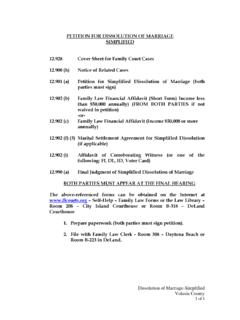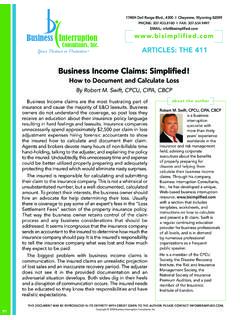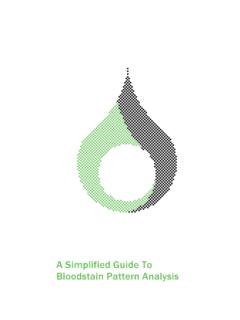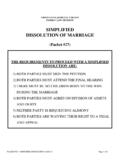Transcription of 19 How many fish are caught each year? - fishcount.org.uk
1 Section 4: Reducing welfare impact by reducing numbers Worse things happen at sea: the welfare of wild- caught fish 70 19 How many fish are caught each year ? In writing this report a key question arises: how many fish are caught each year ? One expects the number to be massive the familiar sight of trawl nets full of fish being emptied on deck suggests that many hundreds may be caught in just a single catch. The numbers of land animals slaughtered for food every year is known, since these are published by the Food and Agriculture Organisation of the United Nations (FAO). These show that 3 billion mammals and 57 billion birds were killed for this purpose in 2008. Unfortunately, FAO statistics on wild- caught and farmed fish are given only in tonnages.
2 Nor, unfortunately, does the FAO publish mean weights of fish , which would enable numbers to be calculated from these tonnages. The number of fish caught each year is an important question for animal welfare assessment because, as discussed earlier, most wild- caught fish are killed ( left to die) in ways that meet no standard of humane slaughter. If not the FAO, has anyone else tried to estimate the total number of fish caught ? There are some estimates for particular species and for the following cases the numbers are huge. It has been reported that the number of sandeels caught (sandeels are small fish that burrow in the sand and are caught industrially for reduction to fishmeal and fish oil) is around 100 billion in a good year (Johannesson et al, 2000).
3 On an even larger scale, it has been estimated that the number of Peruvian anchovy, also largely caught to manufacture fishmeal and fish oil, was trillion (1,306 billion) in 1971 (Froese, 2001). However, searches by the current author revealed no estimate for the total number caught . Despite the lack of official statistics on fish capture numbers, is it possible to estimate them from FAO fisheries capture tonnages and other available data? Searches on the internet show that, to varying degrees of accuracy and representativeness, there is a significant amount of fish size data around and average weights are cited for many species on seafood marketing and angling websites. As part of the project of writing this report, the current author attempted such a task in the following study.
4 Study to estimate numbers of fish caught There are three main parts to the estimate presented in this study to estimate the numbers of fish caught in global fishing each year (Mood and Brooke, 2010): (1) fish for which the FAO reports capture tonnages in single species categories, Atlantic mackerel (Scomber scombus), and for which a mean weight was estimated from available fish size data (2) fish for which the FAO reports capture tonnages in multi-species categories, Anchovies, etc. nei (Engraulidae), and for which mean weights were estimated for the largest and smallest relevant species in each category (3) fish for which the FAO reports capture tonnages in totally general categories, marine fishes nei, together with categories for which the species are given but for which a mean weight could not be estimated.
5 The first part comprises the single species categories for which it was possible to estimate a mean weight, and so estimate fish numbers. Where possible, estimated mean weights were obtained from average weight data but, where these were not available, various other types of Section 4: Reducing welfare impact by reducing numbers 71 data were used. These included typical weights/lengths or weight/length ranges. each type of data was ranked according to the judged relative reliability of estimated mean weights obtained from it, with average weight data ranked the highest. For any mean weight estimate, only the most reliable type of data available was used, including more than one fish size reference where possible.
6 All available data were used in this process, whether from commercial, scientific, sporting or other sources. The second part comprises the multi-species categories for which fish size data were available. To estimate the mean weight for a multi-species category, the mean weight was estimated for the smallest and largest relevant species in the group and combined as a range. Relevant species were those in the species group that are both fished commercially or for subsistence and that are distributed in the region from which more than 20% of capture was taken. Note that the fish numbers estimated from the upper end of each such estimated mean weight range ( the lower end of the estimated number range) will be very conservative since it will be based on the largest relevant species in the group.
7 The mean weights and estimated fish numbers for species categories (single or multi-species) for which it was possible to obtain an estimated mean weight are shown in Table 4 of Appendix A). The third part comprises the species categories for which no estimated mean weight was obtained. The numbers of fish represented by these tonnages were estimated by extrapolating mean weight data from species for which a mean weight had been estimated. Wherever possible, this was based on extrapolated mean weight data for the same taxonomic class of fish species. The estimated mean weights obtained in this study, and the fish numbers estimated for them, will vary in their accuracy owing to the variability of fish sizes and the limitations of the fish size data available.
8 Issues of accuracy and representativeness were addressed as far as possible by including all fish size references for the most reliable types of data available while excluding those that were judged less reliable. Key Results An estimated mean weight was obtained for nearly 70% of fish capture tonnage (average annual capture tonnage for 1999-2007), for which the numbers of fish were estimated at between and trillion individuals. Adding the numbers of fish estimated from extrapolated mean weight data gave the total estimate of trillion. This estimated range is based entirely on the data used; the probability that the actual figure lies within this range has not been calculated, but it is considered that this figure is indicative of the numbers caught .
9 The most reliable estimates of fish numbers are likely to be those based on average weight data taken from more than one reference. These total trillion and account for 29% of fish capture tonnage. In addition, the lower estimate for multi-species categories with an estimated mean weight is likely to be very conservative and totals a further trillion for another 7% of fish capture tonnage. Combining these two figures brings the lower estimate for this 36% of capture tonnage to trillion. It is concluded that the number of fish caught each year is of the order of a trillion. fish capture not included in the estimate This estimate of fish numbers includes only those represented by FAO recorded fisheries capture statistics for the period 1999-2007.
10 It does not include the following: fish caught illegally fish caught as bycatch and discarded fish that die following escape from nets ghost fishing by lost and discarded gears fish caught for the fishers own use as bait but not recorded fish caught for use as feed, either whole or chopped, on fish and shrimp farms but not recorded all other unrecorded or unreported capture. Section 4: Reducing welfare impact by reducing numbers Worse things happen at sea: the welfare of wild- caught fish 72 Global fisheries capture (finfish and shellfish) for the period 1999 to 2007 averaged million tonnes per year , of which million tonnes comprised fish species (FAO, 2009a).







